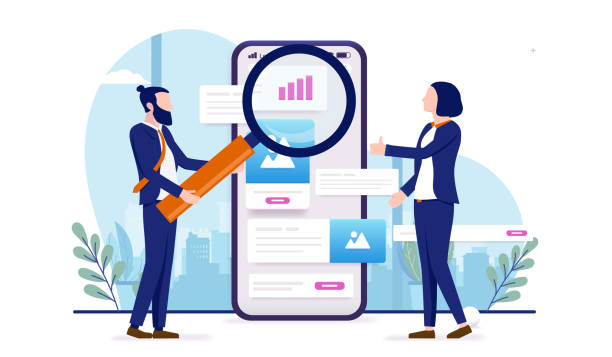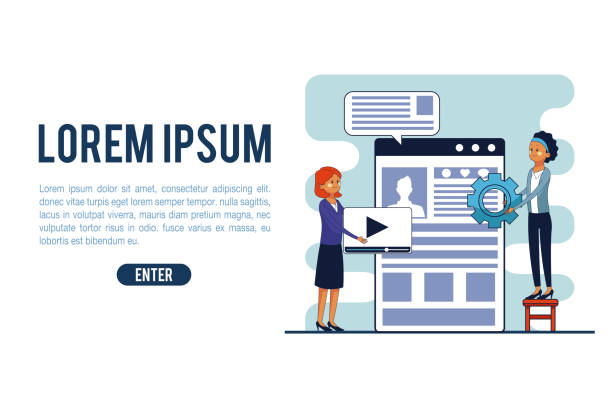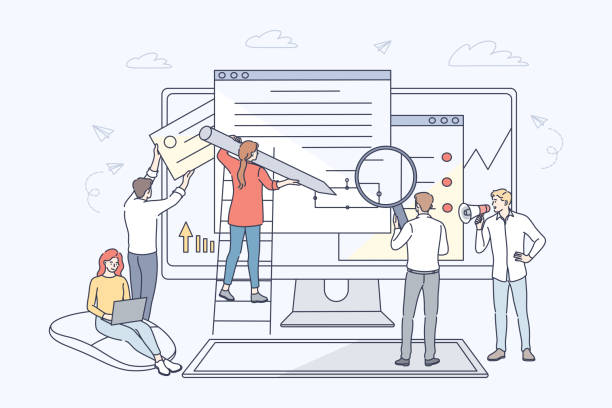The Importance of Multilingual Website Design in Today’s World

In the current era, where geographical boundaries have become meaningless in the digital world, the importance of #global_access to information and services is felt more than ever.
Companies and businesses, to expand their #target_market and remain in fierce #competition, need solutions that enable them to communicate with various audiences worldwide.
Multilingual website design is no longer a luxury option, but a strategic necessity.
This approach allows you to deliver your message in the visitors’ native language and provide them with a personalized and pleasant experience.
Suppose a user from Germany is looking for your services; if your website is only available in Persian, the probability of them quickly leaving the site is very high.
However, if your content is also offered in German, the chance of attracting and converting them into a customer increases dramatically.
This is not only about attracting new customers; it also plays a significant role in retaining existing customers and increasing their loyalty.
A website accessible in different languages shows respect for different cultures and languages, which itself sends a positive message to your global audience.
Beyond customer acquisition, multilingual website design enables businesses to enter emerging and unsaturated markets.
This can include regions with significant populations of different language speakers or countries with high purchasing power seeking specific products and services.
By providing localized content, you not only overcome language barriers but also establish a deeper connection with your audience based on cultural understanding and mutual respect.
This approach directly impacts the increase in organic site traffic, as search engines prefer multilingual and optimized websites for local users.
Consequently, it is a smart strategy for any brand looking to transcend borders and establish a powerful presence in the international arena.
Therefore, investing in building a multilingual website is an important step towards globalizing your business.
This not only helps increase website traffic and improve international SEO, but also opens new doors to emerging markets and strengthens your business relationships.
It is a smart strategy for any brand looking to go beyond borders and establish a powerful international presence, and in a way, it is also an educational approach for your foreign audience.
(Approximately 310 words)
Are you bothered by losing customers who visited your site to buy?
RasaWeb is your specialized solution for a successful online store.
✅ Significant increase in your online sales
✅ Building trust and professional branding with customers⚡ Get free consultation from RasaWeb specialists!
Technical Considerations in Implementing a Multilingual Website

When undertaking multilingual website design, several technical aspects must be carefully considered to ensure correct and optimal site performance.
One of the first important decisions is choosing the appropriate #URL_structure.
Three main approaches include using country code Top-Level Domains (TLDs) (e.g., example.de), subdirectories (e.g., example.com/de/), and subdomains (e.g., de.example.com).
Each of these methods has its specific advantages and disadvantages in terms of SEO and management.
For example, subdirectories are usually easier for SEO because they inherit all the authority of the main domain.
Choosing the #Content_Management_System (CMS) is also crucial.
Systems like WordPress with plugins such as WPML or Polylang, or Drupal and Joomla, offer built-in capabilities for managing multilingual content.
Ensuring that your chosen CMS can support various languages, including Right-to-Left (RTL) languages like Persian and Arabic, is of great importance.
Also, the topic of #website_hosting to support heavy traffic and content from different geographical regions should be considered.
Using a Content Delivery Network (CDN) can improve site loading speed for users worldwide.
Correct implementation of hreflang tags in the HTML code of each page to indicate the relationship between identical language versions is also a vital technical aspect for international SEO.
These tags help search engines display the correct language version to the appropriate users.
This section is specialized and guiding, helping you choose the best infrastructure for your multilingual website design.
Paying attention to these technical details ensures that your multilingual website design project has a solid foundation and demonstrates its full potential in attracting global audiences.
(Approximately 310 words)
Search Engine Optimization (SEO) for Multilingual Websites

One of the biggest advantages of multilingual website design is its potential for improving #international_SEO.
However, achieving this goal requires a targeted and precise approach.
The most important aspect in this regard is the correct implementation of #hreflang_tags.
These tags inform search engines like Google which version of the page is intended for which language and geographical region.
For example, if you have a page in Persian for Iran and another version in English for the United States, the hreflang tags must clearly indicate this.
Incorrect use of these tags can lead to duplicate content issues and harm your site’s ranking.
In addition to hreflang, #geographical_targeting through tools like Google Search Console is also very important.
This tool allows you to specify the target country for each of your top-level domains or subdirectories.
Choosing appropriate keywords for each language is also crucial; a keyword that has a specific meaning in one language may have a different meaning or not be common at all in another language.
Therefore, keyword research should be performed separately for each language and region and include an understanding of cultural differences in search phrases.
Site loading speed, mobile compatibility, and internal and external linking are still important factors in SEO that must be optimized for all language versions of the site.
Finally, ensuring that all translated content is crawlable and indexable by search engines is of high importance.
This section is a specialized guide for optimizing your multilingual website.
(Approximately 280 words)
| URL Structure | Example | Advantages | Disadvantages |
|---|---|---|---|
| Country Code Top-Level Domains (ccTLD) | example.de | Clearest geographical indicator, separate SEO for each region, native feel. | High cost, need for separate domain authority for each TLD, more complex management. |
| Subdirectories | example.com/de/ | Easier to manage, inherits all authority of the main domain, cost-effective. | May have less clear geographical targeting, slightly challenging for some tools. |
| Subdomains | de.example.com | Easy to distinguish, relatively easy to manage, can be good for branding. | Sometimes its SEO is not as strong as subdirectories, requires additional DNS settings. |
Content Strategy and Translation Challenges in Multilingual Website Design

Simply translating content word-for-word is not enough for a multilingual website design.
The content strategy for multilingual sites must go beyond machine translation and move towards complete #localization.
This means that the content must not only be linguistically accurate but also culturally and socially aligned with the target audience.
An example of this localization can be found in the way numbers, dates, currency, and even colloquialisms are expressed.
#Cultural_translation involves adapting the message, tone, and even images to the cultural values and norms of the target region.
Ignoring this aspect can lead to misunderstandings or even unintended offenses.
To ensure #content_quality, collaboration with native translators and marketing specialists familiar with the target culture is crucial.
These individuals can ensure that your message is conveyed correctly and resonates with the audience.
Another challenge is continuous content management; as new content is added in the primary language, the translation and localization process must be carried out quickly and effectively to ensure all language versions of the site are always up-to-date.
Using Translation Memories (TM) and specialized glossaries can help maintain the consistency and quality of translations over time.
Also, reviewing and editing translated content by native speakers to ensure its fluency and naturalness is very important.
This section explains why mere translation is not enough and how you should prepare your content for global audiences.
A successful multilingual website is one whose users feel that the content was originally written for their language and culture, rather than merely translated.
This is an analytical and deep approach to content.
(Approximately 310 words)
Tired of losing customers due to poor e-commerce site design? With RasaWeb, solve this problem forever!
✅ Increase sales and visitor-to-customer conversion rates
✅ Smooth and attractive user experience for your customers⚡ Click to get free consultation!
User Experience (UX) and User Interface (UI) in Multilingual Websites

When designing a multilingual website, paying attention to User Experience (UX) and User Interface (UI) for each language and culture is of paramount importance.
An excellent UX on a multilingual site means that the user can easily find and select their desired language, and then view the content smoothly and pleasantly.
Clear placement for #language_selection, usually in the header or footer of the site, or as a smart pop-up based on the user’s IP, are among the initial considerations.
Ensuring that language change buttons and links are clearly visible and usable is essential.
Also, attention should be paid to visual effects and #element_layout in different languages.
For example, in Right-to-Left (RTL) languages like Persian or Arabic, all visual elements and text must be arranged from right to left, which requires a different design and implementation compared to Left-to-Right (LTR) languages.
Choosing a #suitable_font that supports all necessary characters of different languages and has high readability is also crucial.
Failure to use correct fonts can lead to improper display of characters and an unpleasant user experience.
Other UX aspects include maintaining consistency in navigation and information hierarchy across all language versions of the site so that users can easily move around the site without getting confused when changing languages.
Also, paying attention to page loading speed in different regions of the world and optimizing images and CSS/JS codes for each language version is highly important.
Finally, conducting user tests with native speakers for each language can greatly help identify and resolve potential issues in user experience.
A successful multilingual site is one that not only translates content but also optimizes the interactive experience for each user and thus provides practical guidance for improving your site.
(Approximately 340 words)
Challenges and Solutions for Managing and Updating Multilingual Content

After completing the initial stages of multilingual website design and launching it, new challenges emerge in the continuous management and updating of content.
One of the biggest challenges is ensuring #data_integrity and content synchronization across all languages.
Imagine adding a new product or changing the price of a service; these changes must be applied quickly and accurately in all language versions to prevent inaccurate or outdated information.
This process can be very complex, especially for sites with dynamic content and frequent updates.
Another major concern is the #cost_of_translation and localization, which can quickly escalate.
To address this, using Translation Management Systems (TMS) and Translation Memories (TM) is very useful.
These tools help store previously translated sentences and phrases and can automatically suggest them if the same phrase needs to be translated again, which saves time and helps reduce costs.
Also, establishing a clear #content_management workflow, including stages of creation, translation, review, and publication, is essential.
This workflow must clearly define who is responsible for each stage and how coordination between different teams (content production, translation, developers) is carried out.
Regular planning for reviewing and updating old content in all languages is also vital for maintaining the site’s relevance and freshness.
This process should prevent the publication of outdated or irrelevant content in different language versions.
Paying attention to educational details in project management is also crucial for success.
Considering these challenges and implementing appropriate solutions is the key to the long-term success of a multilingual web platform and can be very useful from a news perspective for companies looking to go global.
(Approximately 330 words)
Practical Tools and Platforms for Developing Multilingual Websites

The correct choice of tools and platforms plays a key role in the success of multilingual website design projects.
Today, numerous Content Management Systems (CMS) support multilingual capabilities and facilitate content management.
WordPress, with its large market share, is one of the most popular options and, through powerful #translation_plugins like WPML or Polylang, allows it to be transformed into a complete #multilingual_CMS.
These plugins enable you to translate and manage content, menus, widgets, and even the site’s theme in different languages.
Drupal and Joomla are other powerful CMSs that offer native multilingual capabilities or through dedicated plugins and are more suitable for larger and more complex projects.
For e-commerce websites, platforms such as Shopify, Magento, and WooCommerce (for WordPress) also provide the ability to manage products and pages in different languages.
In addition to CMS, using #project_management and collaboration tools is essential for coordination among different teams, including translators and developers.
Tools like Asana, Trello, or Jira can help track translation progress and ensure their timeliness.
Also, to ensure translation quality, using specialized grammar and spelling check tools for each language can be beneficial.
Finally, using a Content Delivery Network (CDN) to speed up site loading for users worldwide will definitely be a smart investment.
This set of tools and platforms helps you manage the process of building and managing your multilingual website in the best possible way and provides a specialized guide to get you started.
(Approximately 360 words)
| CMS Platform | Multilingual Support Method | Suitable for | Considerations |
|---|---|---|---|
| WordPress | Plugins (e.g., WPML, Polylang) | Small to medium websites, blogs, corporate websites. | Requires purchasing and configuring plugins, hosting resources, scalability for larger projects. |
| Drupal | Core capabilities and modules | Large and complex websites, corporate portals, government. | More complexity in initial configuration, requires expert developer, steep learning curve. |
| Joomla | Core capabilities and extensions | Corporate websites, portals, social sites, small stores. | Medium learning curve, active user community, good flexibility. |
| Magento | Native capabilities for multilingual stores | Large and enterprise-level online stores, with high volume of products. | High complexity, requires powerful server resources, high maintenance and development costs. |
Measuring Success and Analyzing Performance of Multilingual Websites

After implementing and launching a multilingual website design, the next critical step is #performance_analysis and measuring its success.
Simply having a site in multiple languages is not enough; you need to ensure that this investment yields the necessary returns and helps achieve your business goals.
Using #web_analytics_tools like Google Analytics is essential for monitoring traffic, user behavior, and #conversion_rates for each language version.
These tools allow you to see which countries and languages users are coming from, which pages are most popular, and how they interact with your content.
By segmenting data by language and region, you can gain valuable insights into the effectiveness of your strategy.
For example, you might notice that the bounce rate in a specific language is very high, which could indicate problems with translation, localization, or user experience for that group of users.
Conversion rate for each language is also a key metric.
Do French users convert to customers as much as English users? If not, what factors might contribute to this difference? These questions can help in continuous content and design improvement.
Also, tracking keyword rankings in local and international search engines for each language helps you evaluate the effectiveness of your multilingual SEO efforts.
By carefully examining these metrics, you can identify the strengths and weaknesses of your international website and make data-driven decisions for continuous optimization and improvement.
This is an analytical and educational approach that helps you maximize the return on your investment in multilingual website design and answer questionable content regarding your site’s efficiency.
(Approximately 320 words)
Do you have an online store, but your sales are not as expected? RasaWeb solves your problem forever with professional e-commerce website design!
✅ Significant increase in conversion rates and sales
✅ Unparalleled user experience for your customers
⚡ Click to get free consultation with RasaWeb!
The Future of Multilingual Website Design and Emerging Trends

The digital world is rapidly evolving, and multilingual website design is no exception.
Emerging trends in technology and user behavior are shaping the future of multilingual websites.
One of the most prominent trends is the significant advancements in #advanced_machine_translation and Artificial Intelligence (AI).
Deep learning algorithms are now capable of producing translations that are very close in quality to human translations, which can speed up the localization process and reduce costs.
However, there will always be a need for human review and correction to ensure cultural and tonal accuracy and prevent entertaining but damaging errors.
#Voice_search and smart assistants also play an increasing role in how users interact with the web.
This means that multilingual websites must be optimized to respond to voice queries in different languages, which requires a precise understanding of how people speak in each language and the use of local idioms.
The emergence of #Virtual_Reality (VR) and Augmented Reality (AR) can also provide new opportunities for delivering multilingual content, allowing users to receive information in their preferred language in interactive virtual environments.
These technologies enable businesses to provide completely immersive and personalized experiences for their global users.
The increasing importance of headless CMS platforms also allows teams to create multilingual content once and publish it across various channels (website, mobile application, voice assistants, etc.) in different languages.
These changes open new horizons for global communications through multilingual websites and provide unparalleled opportunities for innovation.
This is a news and entertaining section that illustrates the future of multilingual website design.
(Approximately 340 words)
Conclusion and Next Steps Towards Globalization

In this article, we examined various aspects of multilingual website design; from its strategic importance in today’s world to technical considerations, SEO challenges, content localization, user experience, available tools and platforms, and finally, performance analysis and future trends.
It is clear that having a multilingual website is no longer just a competitive advantage, but an essential cornerstone for any business that aspires to #business_globalization and expanding its reach.
This approach not only helps you enter new markets but also significantly strengthens #audience_connection at an international level and increases your brand’s credibility.
Success in this path requires careful planning, appropriate investment in quality translation and localization, and continuous attention to technical aspects and user experience.
By considering the points raised and using the right tools, you can create a powerful and effective multilingual website that helps you achieve your global goals.
The future of the web belongs to those who are ready to deliver their message to the whole world.
By stepping on the path of multilingual website design and focusing on #sustainable_growth and international communications, you can be sure that your business will be ready to face the challenges and capitalize on the opportunities of the global market.
This section provides a descriptive and guiding comprehensive summary of the topics presented.
Now is the time to turn your website into a bridge to connect with the world and leverage the full potential of multilingual website design.
(Approximately 310 words)
Frequently Asked Questions
| No. | Question | Answer |
|---|---|---|
| 1 | What is multilingual website design? | Multilingual website design means creating a website whose content is available to users in several different languages. This is usually done through a simple user interface for language switching. |
| 2 | Why should we design a multilingual website? | Multilingual website design helps you reach a wider audience worldwide, provide a better user experience for international users, and improve your global SEO. |
| 3 | What are the main methods for implementing multilingualism on a website? | The main methods include using subdomains, subdirectories, or URL parameters for each language, as well as using completely separate domains for each language. |
| 4 | Is it better for SEO to use subdirectories or subdomains? | From an SEO perspective, both subdirectories and subdomains can be effective. However, many SEO specialists prefer subdirectories due to better passing of main domain authority. |
| 5 | What are the important points in translating multilingual website content? | Translation should be done by native translators, content should not only be translated but also localized to match the target audience’s culture, and pure machine translation should be avoided. |
| 6 | What is the role of hreflang tags in multilingual website SEO? | Hreflang tags help search engines like Google display the correct language and regional version of a page to the appropriate users, which also prevents duplicate content issues. |
| 7 | Can a website be made multilingual without coding? | Yes, in Content Management Systems (CMS) like WordPress, there are powerful plugins such as WPML or Polylang that enable multilingual website creation without the need for coding. |
| 8 | What are the challenges of multilingual website design? | Challenges include translation management, content localization, adherence to SEO principles for each language, technical support for different languages, and ensuring design consistency across different languages. |
| 9 | What is the difference between translation and localization? | Translation is merely rendering words from one language to another, whereas localization involves adapting content to the culture, customs, currency, date and time formats, and even appropriate colors for the target audience. |
| 10 | What is the best User Experience (UX) for language switching? | A clear and accessible language switcher (usually in the header or footer), using language names instead of flags (due to regional variations), and maintaining the user’s position after changing language are important UX points. |
And other services of RasaWeb Advertising Agency in the field of advertising
The role of technical support in the success of medical equipment advertisements
How to use CRM systems in ad management
The impact of multilingual content on medical equipment export advertisements
How to design sustainable and environmentally friendly advertisements?
And over hundreds of other services in the field of online advertising, advertising consultation, and organizational solutions
Online Advertising | Advertising Strategy | Advertorials
🚀 Are you looking for a big leap in your online business? RasaWeb Afarin, by providing comprehensive digital marketing services including fast and professional website design, SEO, and social media management, paves your way to success. Experience a powerful and influential presence in the digital world with us.
📍 Tehran, Mirdamad Street, next to Bank Markazi, Kazeroon Jonubi Alley, Ramin Alley, No. 6

